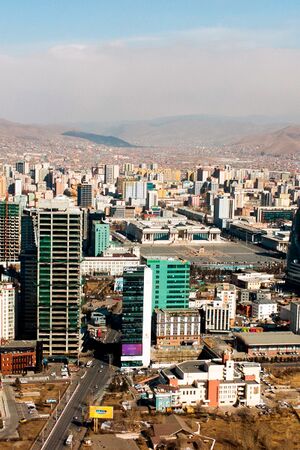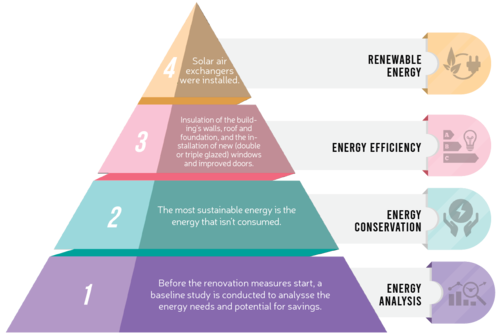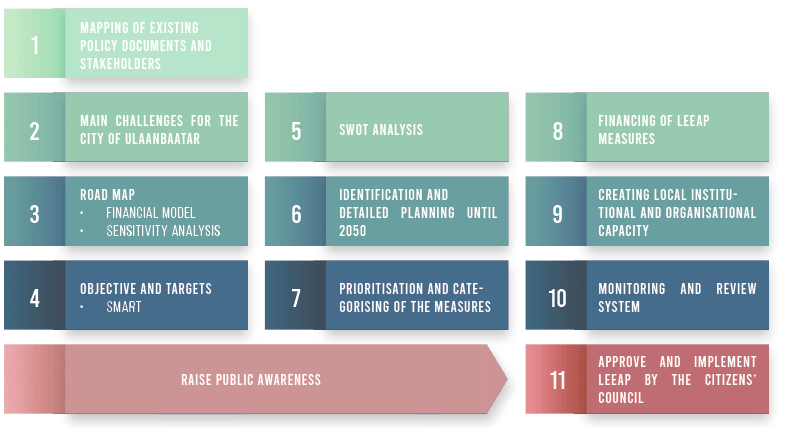Knowledge fuels change - Support energypedia!
For over 10 years, energypedia has been connecting energy experts around the world — helping them share knowledge, learn from each other, and accelerate the global energy transition.
Today, we ask for your support to keep this platform free and accessible to all.
Even a small contribution makes a big difference! If just 10–20% of our 60,000+ monthly visitors donated the equivalent of a cup of coffee — €5 — Energypedia would be fully funded for a whole year.
Is the knowledge you’ve gained through Energypedia this year worth €5 or more?
Your donation keeps the platform running, helps us create new knowledge products, and contributes directly to achieving SDG 7.
Thank you for your support, your donation, big or small, truly matters!
Local Energy Efficiency Action Plan
Why Energy Efficiency is Crucial for the Sustainable Development of Mongolia
Buildings are responsible for 40% of global energy consumption, and 33% of greenhouse gas emissions. More than 80% of Ulaanbaatar’s district heating is used to heat the city’s buildings, which contributes to at least 50% of Ulaanbaatar’s carbon emissions. The city consists of old building stock mainly built during the socialist era. As a consequence, and due to a lack of refurbishment activities, the insulation of most buildings is poor.It is critical to ensure that new buildings are sustainable, and energy-efficient. However, given the thermo-technical refurbishment of a building is around eight times cheaper than constructing a new one, it is also crucial to widely refurbish old structures in the city, and across Mongolia.
Increased energy efficiency in the building sector results in reduced heating needs and this in turn to lower fine particle emissions, and lower CO2 emissions. The heat demand in Ulaanbaatar increases by approximately 7% each year while the supply capacity is not increasing at that rate and therefore does not meet the demand. Instead of investing in new coalbased heat plants, there is the chance to lower the heat energy demand by about 50% with simple energy efficiency measures. This is a win on many levels compared to building new coal-based heat generating capacities:
- lower investment costs
- lower CO2 emissions
- running costs remain at the same level (instead of higher costs, due the expense of more power plants)
- increased temperatures, and living comfort for residents
Energy Pyramid on the Example of a Thermo-technical Refurbishment of a Kindergarten
In order to demonstrate the approaches used to gain an efficient and sustainable energy system for the City of Ulaanbaatar, the bottom-up approach of the energy pyramid has been used within the project’s implementation.- Energy Analysis: Before the renovation measures start, a baseline study is conducted to analyse the energy needs and potential for savings. Heat meters and mixing loops are installed in the buildings to find out how much (heat) energy is received per year. At the same time indoor air temperatures are measured at different locations of the building. In many cases the heat received is not sufficient to meet the energy demand, and it remains cold in the buildings.
- Energy Conservation: “The most sustainable energy is the energy that isn’t consumed.” Ways of conserving (not using) energy were analysed and implemented. For example, it is recommended to ventilate rooms briefly but intensively, instead of leaving windows open for longer periods of time. If heat regulators are installed, it is suggested to reduce the heating inflow, if temperatures are too high. In the case of schools and kindergartens, the temperature can be reduced on weekends.
- Energy Efficiency: One of the main activities within the project was to conduct the thermo-technical refurbishment of 22 public buildings. This was achieved by improving the insulation of walls, roofs and foundations, and the installation of new (double or triple glazed) windows and improved doors. Further, the installation of mixing loops provides the ability to control the temperature in different areas of buildings, which is highly beneficial when it comes to saving energy as the south facing sunny side usually requires less heating.
- Renewable Energy: Solar air exchangers were installed on several buildings, only after energy consumption was reduced. Since the energy consumption was reduced by between 40 – 55% it is possible to use a higher degree of renewable energies in the future to further reduce the emissions of the building.
Introducing a Local Energy Efficiency Action Plan (LEEAP) in Ulaanbaatar
The City of Ulaanbaatar’s priority is to be a safe, healthy, and green city that is resilient to climate change. This will be achieved by providing a liveable environment for its residents through appropriate land use, planning, infrastructure, and housing. This target is challenging, and will need a great number of actions to demonstrate how the city can reduce greenhouse gas emissions from transport, electricity, heating, power generation and transmission within the city boundaries.
A first step to tackle this challenge is to focus on the building sector by introducing a Local Energy Efficiency Action Plan (LEEAP) for the City of Ulaanbaatar, with practical and immediately applicable actions. Between 2019 and 2020 a multi-stakeholder process took place to create the LEEAP. Through many workshops, along with the support and steering of international consultants and the GIZ, the plan was developed by the Municipality of Ulaanbaatar, the Ministry of Construction and Urban Development, the Energy Regulatory Commission and non-governmental organisations.
"The LEEAP will enable Ulaanbaatar to reach important energy efficiency targets and most importantly improve the city’s air quality. It also includes measures in the field of monitoring and energy management , which will support the City of Ulaanbaatar to develop new climate and energy efficiency goals and plans in the future." – T. Kherlen, Head of Engineering Department of MUB
What is a Local Energy Efficiency Action Plan?
A LEEAP describes actions that will be decided by the councils of the city for reaching energy efficiency targets in the building sector, and also improving air quality. It also includes monitoring and energy management actions, which will support the development of new climate and energy efficiency goals. LEEAPs are the first step in the right direction for a safer, healthier, and greener city; establishing a common understanding of the starting point, and the setting of short, mid, and long-term targets. A LEEAP shall be used as a guiding document and reference for budgeting programmes and operational planning to deliver building renovation programmes. The plan sets a boundary for planned interventions and includes a first attempt to quantify the size of the problem.Tapping into energy saving and building renovation projects, requires policies and mechanisms to develop and deliver large numbers of relatively small projects, which are scattered amongst thousands of buildings in different sectors. As such, the energy efficient renovation of buildings often does not compete well against other opportunities for using up-front capital, such as capacity expansion of power plants or a new wind farm. Barriers and problems exist, such as high transaction perceptions. Unmet needs for technical expertise and lack of financial intermediation mean that much of the potential for saving energy will remain untapped and the existing building stock will dilapidate further. Institutional innovation is required to address these barriers, and to put in place efficient policies and programmes for identifying ways of delivering building renovation projects.
Ulaanbaatar's Way Forward
The initial actions for the city of Ulaanbaatar to consider are institutional capacity development, clear management structures and processes to deliver building renovation and energy efficiency. Only then do the proposed actions become more concrete, initially with pilot projects, then followed by market up-scaling. The boundaries of this LEEAP are the four building sectors:
- public buildings
- multifamily buildings
- single-family buildings in ger districts
- new buildings
In this initial period, it is suggested that the city will strive to gradually introduce cost recovery tariffs, which is an essential element for supporting energy efficiency programmes. With regards to new building construction, the City of Ulaanbaatar strives to introduce mandatory energy performance certificates and norms to ensure the energy efficient design of buildings. A priority of the City is to limit new sources of pollution, therefore evaluating and enforcing connection to the existing district heating system as part of this plan.
LEEAPs for the Mongolian Regions
It is not only Ulaanbaatar that is struggling with an old building sector and poor air quality, so are most cities in Mongolia. The 2015 Energy Conservation Law requests all aimags (provinces) to develop local policies on energy saving and to implement them in cooperation with relevant organisations culminating in regional LEEAPs. Developing the LEEAP in Ulaanbaatar with various stakeholders with at times opposing interests, was challenging but much was learned. The learned experiences are valuable for other Mongolian regions. GIZ will carry out five regional conferences to share good practices and possible obstacles, in Khovd, Orkhon, Tuv, Khentii and Ulaanbaatar.
To train local practitioners in developing LEEAPs, a guidebook has been developed. It gives more insights into the development stages and splits up the work into 11 easy-to-follow steps. Adhering to the steps will help local authorities developing and implementing their first LEEAP. It will help by saving energy and contribute to better air quality and improved living conditions.

























